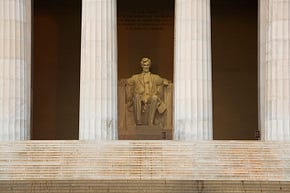|
 |
“Baby” by Ron Carlson from Room Service. © Ron Carlson. Published by Red Hen Press, 2012.
ORIGINAL TEXT AND AUDIO - 2017
On this day in 1922, the Lincoln Memorial was dedicated. The monument was first proposed in 1867, but construction didn't begin until 1914; the cornerstone was set in 1915. Architect Henry Bacon designed it to resemble the Parthenon, believing that a defender of democracy should be memorialized in a building that pays homage to the birthplace of democracy. The monument has 36 marble columns, one for each state in the union at the time of Lincoln's assassination. On the south wall is inscribed the Gettysburg Address, and on the north, his second inaugural address. There's a persistent myth that one of the words in the inaugural address is misspelled, but it's not true. Stonemasons did accidentally carve an "E" where they meant to carve an "F," but it was filled in immediately and no evidence remains.
The marble and granite chosen for the monument came from Massachusetts, Colorado, Georgia, Tennessee, Indiana, and Alabama. Bacon intended to show the divided nation coming together to build something of lasting significance.
Sculptor Daniel Chester French studied photographs of Lincoln for years; his Lincoln appears somber, even care-worn, one hand closed in a fist and the other in a more relaxed position. Though it's commonly thought that the sculpture's hands are forming the American Sign Language letters "A" and "L," the National Park Service reports that this was French's way to show Lincoln's strength and compassion. There's also a rumor that the profile of Robert E. Lee — or Ulysses S. Grant, or Jefferson Davis — can be seen in the locks of the sculpture's hair, but the National Parks Service insists that these are merely wayward strands.
The monument was dedicated in front of an audience of more than 50,000 people. Even though Lincoln was known as the Great Emancipator, the audience was segregated; keynote speaker Robert Moton, president of the Tuskegee Institute and an African-American, was not permitted to sit on the speakers' platform. Just over 40 years later, on the 100th anniversary of the Emancipation Proclamation, Martin Luther King Jr. would give his "I have a dream" speech from the steps of the Lincoln Memorial, in front of an audience of 200,000.
It was on this day in 1849 that Henry David Thoreauself-published A Week on the Concord and Merrimack Rivers, his first book. It was an account of the two-week boating trip Thoreau had taken with his brother, John, 10 years before, from Massachusetts to New Hampshire and back.
Thoreau had always been the introverted and studious one, while John was gregarious and fun-loving. They were close; John helped pay his brother's tuition to Harvard, and helped Thoreau open his own school when he got fired from his teaching job over his objection to corporal punishment. A few years after their boat trip, John died in his brother's arms, unexpectedly, from tetanus. Thoreau decided to seclude himself and began building a cabin by the banks of Walden Pond. He lived there for two years, completing the drafts of both his A Week, often seen as a memorial to his brother, John, and a series of lectures that would eventually become the classic Walden. Since A Week was initially rejected, Thoreau was only able to publish it by paying for its printing from its sales. Four years later, after paying off the printing debt, Thoreau wrote in his journal that his publisher had delivered the remaining unsold copies to his home. He wrote, "I have now a library of nearly nine hundred volumes, over seven hundred of which I wrote myself."
Thoreau said: "To affect the quality of the day, that is the highest of arts. Every man is tasked to make his life, even in its details, worthy of the contemplation of his most elevated and critical hour.
And, "I went to the woods because I wished to live deliberately, to front only the essential facts of life, and see if I could not learn what it had to teach, and not, when I came to die, discover that I had not lived."
Be well, do good work, and keep in touch.®
THE WRITER’S ALMANAC HAT - CLICK HERE
You’re a free subscriber to The Writer's Almanac with Garrison Keillor. Your financial support is used to maintain these newsletters, websites, and archive. Support can be made through our garrisonkeillor.com store, by check to Prairie Home Productions P.O. Box 2090, Minneapolis, MN 55402, or by clicking the SUBSCRIBE button. This financial support is not tax deductible.


